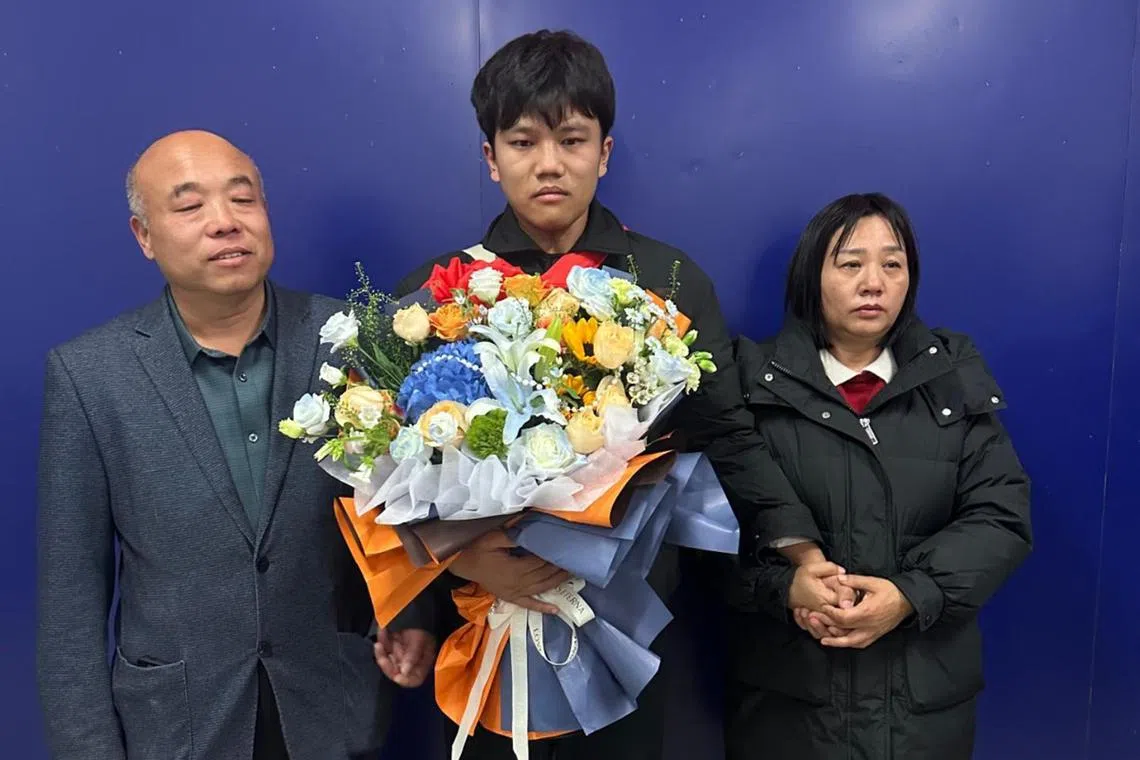Facial recognition tech reunites abducted boy in China with family after 25 years
Sign up now: Get ST's newsletters delivered to your inbox

Mr Xie Kefeng and his wife reunited with their son after 25 years.
PHOTO: WEIBO
Follow topic:
XINGTAI – It took 25 long years, but 52-year-old Xie Kefeng was finally reunited on Dec 1 with his son, who had been snatched from his parents as an infant.
The power of technology, specifically a facial comparison algorithm that takes age-related changes and family similarities into account, played a major role in bringing about the happy outcome.
In 1998, Mr Xie and his wife lived in Xingtai, Hebei province, where they ran a small business.
A few days before the Spring Festival that year, Mr Xie’s wife stepped out of home to buy groceries, leaving their second son Xie Qingshuai, who was three-month-old, on the bed with the door unlocked.
When she returned 10 minutes later, the child had disappeared.
The couple reported the incident to the police and mobilised relatives and friends for a search that extended to many cities and provinces, but the child could not be found.
As there were no photographs of the baby, artists’ impressions were used on the notices announcing the abduction. The father continued with his search, spending almost all his savings in the process.
They tried to move on with their lives, but the abduction hit the couple hard.
The boy’s mother slipped into depression, and remained on medication for almost 10 years.
During this time, the couple kept working and searching, hoping to provide their son with a better life if, and when he returns.
“I always believed that he is still alive and I will eventually find him,” said Mr Xie.
In late November 2023, Mr Xie received a call from the police informing him that a facial comparison had led to his son being found. A DNA comparison confirmed that it was indeed his long-lost son.
Two people had been involved in the abduction. One was dead and the other was taken into custody by the police. An intermediary who sold the baby was also apprehended.
Mr Xie Qingshuai, who now works in Chengdu in Sichuan province, was reunited with his parents and older brother on Dec 1, and met his two sisters for the first time.
Unknown to his family, he had been sold to a couple who lived in Handan, a city in Hebei.
After the man he knew as his father died, his wife remarried and moved away, leaving Mr Xie Qingshuai to be brought up by his adoptive grandparents.
On Dec 3, Beijing DeepGlint Technology Co, an artificial intelligence technology company, announced on its official Sina Weibo social media account that a facial comparison algorithm developed by it had played a vital role in the reunion.
In an accompanying video, the company explained that most abducted children are separated from their families at a young age, and their appearances undergo significant changes as time passes, posing a challenge to police investigations.
Based on the principle that facial features among relatives tend to be similar, the company’s algorithm is able to identify highly relevant potential matches, which significantly improves the efficiency of the search process.
The company said it used photos of both parents and the boy’s older brother to help the facial comparison algorithm narrow the search down to five possibilities.
It said that Mr Xie Qingshuai was the fourth abducted person it had helped the police to locate in the past six months.
Mr Shen Junliang, another father who was reunited with his abducted son in 2020 after 15 years of searching, said on Weibo on Dec 2 that facial recognition technology was of great assistance in the search for missing children, offering hope to many families.
The Ministry of Public Security’s Criminal Investigation Bureau said it wants to promote the use of technologies, including facial recognition technology, to combat child trafficking and help reunite abducted children with their biological parents.
In 2009, the ministry established a national DNA database to combat child abduction and trafficking.
In May 2016, it established the Emergency Information Release Platform for Missing Children, known as the “Reunion System”.
With a focus on the location where the child went missing, the system can disseminate related missing information to the public within a specific geographical range via 25 mobile applications and various new media channels.
By July 2022, the ministry had established 5,000 free blood collection points nationwide, aiming to facilitate timely blood collection for families needing a DNA match. CHINA DAILY / ASIA NEWS NETWORK

